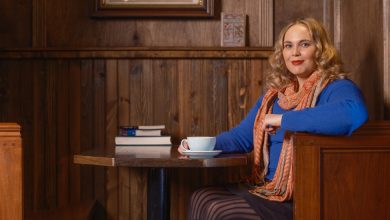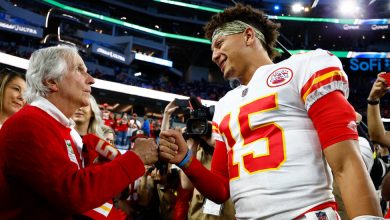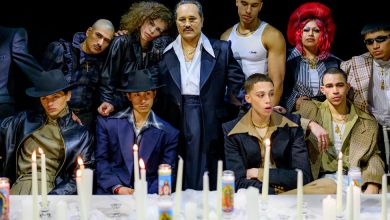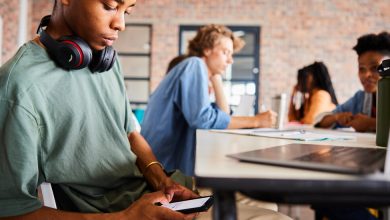A Stranger Looked Like My Twin. That Was Just the Beginning.

I was asleep when my identity exploded. One Friday morning in 2019, I awoke in Brooklyn to an email from a guy in Florida that read: “23andMe says you’re my half sister. I’m very confused. Can you please call me?”
As I stared at his profile photo, I saw that we looked like twins. We even had the same tiny dimple on our nose tips. We had been born a year apart five decades earlier. I had taken a 23andMe test the year before.
Dialing his number, I knew we wouldn’t start with small talk. Indeed, it took us about half a minute to awkwardly theorize: My adored father must have had an affair with this fellow’s mother. But within a few hours, we had both spoken to family members who told us the secret they had promised our parents they would take to the grave: Our fathers had been infertile, and we had been conceived from donor sperm. The donor had been a resident at Yale New Haven Hospital, where scientists were pioneering intrauterine insemination (a.k.a. the turkey baster).
I had known plenty of my family’s secrets, but this time the secret was me. Nothing had changed but everything was different. My family was still my family, and my loving parents were long gone, making this slightly less complicated. But I would have to revise the final manuscript of my life. As a writer, I disliked large-scale changes.
Nevertheless, my new biological brother (immediately entered as “BB” on my phone) and I were in constant contact, splashing around cluelessly in our new gene pool.Having grown up a “lonely only” child, I was exhilarated. After joining the “We Are Donor-Conceived” Facebook group, we learned the term “diblings” — donor siblings.
I couldn’t explain why this stranger was worthy of my fierce adoration or attentive gaze, but my DNA seemed encoded with clear instructions: “Stare. Bond. Fixate.”
This was as all-consuming as new love, but this time my main man looked like a photo generated by that app that shows you as the opposite gender. I had never seen my face in anyone else’s. I created a “BB” album on my phone and spent my commutes zooming in on his face.
I set a “stardust” sound for his texts, a twinkly nod to the Joni Mitchell song I had on constant repeat: “We are stardust, we are golden … And we’ve got to get ourselves back to the garden.”
Before my dibling appeared, I had been longing for connection, halfheartedly dating a widower I met online. Now, smitten by my closest known living DNA relative, I didn’t have much bandwidth for romance (and neither did the widower, it turned out).
When BB visited and the waitress at lunch asked if we were siblings, my heart fluttered.
The double helix diagram is a color-coded spiral ladder with chemical-base rungs. Every day, I climbed it and swung around, exploring, gobsmacked. Chromosomes are the tiniest, hugest things in the world. If you believe the nurture theory, they’re unimportant (as plenty of smart people who love me proclaimed confidently:“It’s just sperm!”). But if you believe the nature theory, they’re the end-all be-all.
I think it’s both, though I had fallen deep into my own chromo-zone. Finally, I was no longer alone; my new brother was there.
Right away, BB wanted to find our donor, whom we referred to as “Our Guy.” After 10 weeks of genetic sleuthing through a line of second cousins on 23andMe, BB reached our holy grail. Our Guy was alive, a retired obstetrician in Nashville. He was 79 and looked good. He had a name, Frank. He had a face; it was kind. It also looked a lot like ours. His name might as well have been named “Gene.”
Frank was married with two grown sons and a daughter. On Facebook, we stared at them too.
We decided to write Frank a joint letter, but my heart sank as our first conflict as siblings unfolded in the tracked comments on our drafts. My approach was heartfelt and detailed; BB’s was jaunty and brief. We both wanted the same thing — a response — but held stubbornly to our own strategies. We each feared the others’ style would lead to silence, or, worse, a cease-and-desist letter, which happens. Such a cosmic dismissal would have been intolerable, and I became pre-furious with Our Guy for his possible rejection.
Finally, I told BB to just send his version and not mention me.
“It’s not a bad idea,” he said. “I’ll do the reconnaissance, and if he doesn’t respond, you can’t take it personally.”
But bowing out of the letter left me feeling alone once again, guilty for abandoning our joint effort, and also terrified that BB would now disappear. “This whole thing falls apart without him,” I said, sobbing, on my therapist’s couch.
Three weeks later, BB received a carefully composed letter on the good doctor’s letterhead. It was empathic and respectful. He said he was open to more communication, so he and BB set up a call.
The second they hung up, BB called me.
“I closed my eyes,” he said, “and let his voice wash over me.” A new father himself, he was uncharacteristically flustered. “It was like how babies recognize their parents’ voices. Like the way they know your smell.”
In their conversation, he also told Frank about me.
When Frank and I spoke a few days later, I heard the same mensch-y timbre in his voice. With pen and paper in hand, I asked and he answered. His intentions? Sure, he’d wanted to help infertile couples and be part of the science, but he also needed the $25 per “live specimen.” No, no other offspring had come forward. Yes, he’d been preparing himself for a letter like BB’s, but had still struggled with his response. No, he’d never thought much about the possible outcomes of his donations. No, he wouldn’t have donated if it hadn’t been anonymous.
Frank was somehow both humble and full of a professor emeritus’s self-regard, but mostly he seemed proud that his genes had unfolded well. I liked his combination of gravitas and sweetness.
“There’s no road map for this,” he said, “but I believe we’ll find our way.”
In my notes, that sentence deserved double underlining.
After we hung up, I didn’t know what to do. It was hot and humid, and I wandered in my shorts and tank top into the Long Island Sound as if being baptized or reborn, oblivious to the seaweed clinging to my skin. I floated. It felt primal.
Then Frank invited us to his place in Boca Raton for a weekend. BB and I stayed in the same hotel nearby, but because of travel schedules I arrived solo a day earlier and met Frank at his condo. As he walked across the room, tan and smiling, I felt the same magnetic pull I’d felt with BB.
“Well, here you are,” he said, arms out. In this weirdest hug of my life, my body hummed and tingled.
“Here I am,” I said. “And here you are.”
“Well, here we are then,” he said.
He stepped back, keeping his hands on my shoulders. “Wow, you’re a person,” I responded stupidly. Here he was in flesh and blood, his life force roaring through me.
“I haven’t seen my mother’s face in decades,” he said, witnessing his genes extending and expanding into the past and into the future.
Swimming in warm Atlantic waves, we learned that we shared the same wrinkle pattern around our eyes, the same extroversion and the same bunions. On a display of paint chips, only one would match our eye color (something like “aquamarine haze”). My heart tumbled with affection.
Two and a half years later, I’m no longer as obsessed. Frank and I have had two in-person visits, BB and I have had five. My four half siblings (and 11 new nieces and nephews and four siblings-in-law) and I are building relationships, alternating serious, silly, intimate and breezy. Our group text chain is called “Big Bamily” (bonus family) and sometimes includes cute DNA emojis.
There’s not much conventional wisdom around dealing with these increasingly common DNA surprises, but everyone in our story seems to believe that life and human connection should be celebrated no matter how weird the circumstance. After all, our progenitor is a professional nurturer of the life force, having devoted his career to high-risk pregnancies and delivering more than 10,000 babies.
Frank has described to me his feelings when his children were born: “It’s like instant pudding. Add water and stir, and you get love.” But with BB and me, it’s more like: “Add science and stir, and you get great affinity and fondness.”
No one has said “I love you,” at least not yet. But we all seem to keep saying “I like you,” which feels more important right now. In finding Frank and the others, BB and I have gotten ourselves back to the garden.
Kama Einhorn is an Emmy Award-winning “Sesame Street” writer and author of “True Tales of Rescue,” a middle-grade series about animal sanctuaries. She lives in Brooklyn.
Modern Love can be reached at [email protected].
To find previous Modern Love essays, Tiny Love Stories and podcast episodes, visit our archive.
Want more from Modern Love? Watch the TV series; sign up for the newsletter; or listen to the podcast on iTunes, Spotify or Google Play. We also have swag at the NYT Store and two books, “Modern Love: True Stories of Love, Loss, and Redemption” and “Tiny Love Stories: True Tales of Love in 100 Words or Less.”





